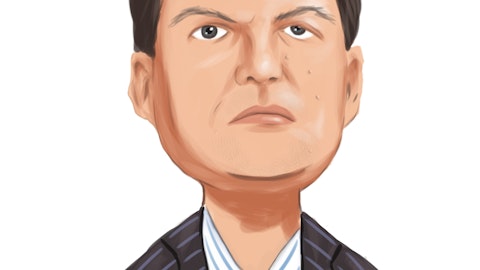Kimball International, Inc. (NASDAQ:KBAL) Q2 2023 Earnings Call Transcript February 2, 2023
Operator: Good afternoon, ladies and gentlemen. My name is Sarah, and I will be your conference call facilitator today. At this time, I would like to welcome everyone to the Kimball International Second Quarter Fiscal 2023 Earnings Conference Call. As with prior conference calls, today’s call, February 2, 2023, will be recorded and may contain forward-looking statements as defined under the Private Securities Litigation Reform Act of 1995. Actual results could differ materially from the forward-looking statements. Risk factors that may influence the outcome of forward-looking statements can be seen in the Kimball International Form 10-K. During today’s call, the presenters will be making references to an earnings slide deck presentation that is available on the Investor Relations section of Kimball International’s website.
On today’s call are Kristie Juster, Chief Executive Officer of Kimball International; and T.J. Wolfe, Chief Vice President and Chief Financial Officer. I would now like to turn today’s call over to Kristie Juster. Ms. Juster, you may begin.
Kristine Juster: Good afternoon, everyone, and thank you for joining today’s call. I’m pleased to share in the second quarter of fiscal 2023, we drove significant year-over-year revenue growth in all our end markets, Workplace, Health and Hospitality. And this marks the fourth consecutive quarter of strong gross margin expansion, delivering 550 basis points improvement year-over-year. We are especially pleased by Kimball International’s continued ability to outperform the industry despite a challenging macroeconomic environment and heightened recessionary risks. After our last earnings call, from early November through mid-December, we saw a softening of demand in our Workplace and Health end markets. While we observed this across many of our geographic regions, the slowdown was more pronounced in major metropolitan markets such as New York and San Francisco.
It is also important to note this quarter faced a strong bookings comp from the previous year as we experienced a pull forward from pricing actions taken in December 2022. Through our conversations with our customers and dealer partners, we can the slowdown in an order conversion to macroeconomic headwinds combined with a continued forming view of the hybrid Workplace. Our upstream activity and sales funnel continues to be strong. However, for many projects that average time to close a transaction has increased by several weeks and in some cases with our larger health systems even by month. Demand in secondary markets, which makes up 79% of our trailing 12-month sales was down as well, but to a lesser degree, outperforming primary markets by more than 10 points.
And we believe this strategic focus has proven to provide resiliency throughout the market downturn and will accelerate our return to demand growth. Order patterns during the second half of December and into January have seen a material improvement with Workplace and Health orders in January up approximately 10% year-over-year. Turning to our end markets. In the second quarter, our largest end market Workplace saw a sales increased 15% year-over-year, and our view on return to office is highly consistent. The office matters more than ever in a hybrid format. It is beyond a workspace, but a place to create the longing community and connection. We believe hybrid is here to stay and it will influence location, size and format of offices, setting up secondary markets and ancillary categories as the highest growth areas.
This hybrid change will require flexibility and an employee-centric environment, turning the office from a space to a personalized place filled with a wide variety of formats servicing individual work, collaboration and community. With return to office as new record highs, companies are settling into and becoming more comfortable with defining their own unique hybrid work strategies. As one of the largest manufacturers of ancillary products, which comprised 88% of our trailing 12-month sales, our comprehensive product portfolio is structured to benefit from this trend. Poppin’s Q2 performance has been softer due to a heavy reliance on the top 5 major metro markets for its core B2B business model. We continue to offset this with focus and delivery around our new incremental growth initiatives.
PoppinPro revenue continued to comprise more than 50% of overall top end sales for fourth quarter in a row. And our new Pod category grew more than 35% sequentially and more than 75% year-over-year. We are also excited to launch the second generation of our Pods this quarter, which provides a full array of functional upgrades, including enhanced privacy, mobility, durability and accessibility through our new ADA-compliant model. These new Generation 2 Pods are now available through both our Poppin direct selling organization and our Kimball International dealer sales team. We continue to expand the incremental opportunities with the Poppin brand and categories and the role they play at Kimball International in the diversification of our channels and synergies within our Workplace and Health business.
Sales to our Health end market increased 17% year-over-year in the second quarter as the adaptability and flexibility of our product portfolio continues to effectively address the needs of health care facilities to maximize efficiency and quality of care. In December, we became a key supplier to HealthTrust, one of the largest group purchasing organizations in the United States, which serves over 1,800 hospitals. We are already seeing significant adoption and traction with this key customer to anticipate for results and further market share gains. During Q2, we also made significant progress on our 3 key initiatives of our Perfect Harmony go-to-market strategy. We activated our new customer excellence operating model designed to deliver industry-leading personalized customer service experiences, launched a multi-branded specification and ordering capability for our full Workplace and Health portfolio and are going live in a few days with our brand-new Kimball International website.
Our new unified infrastructure delivers a seamless experience for all our brands and shares market insights and trends across our distribution partners and our end users. These key enablers truly unleash the power of Perfect Harmony and our unified multi-branded go-to-market strategy. We are also incredibly proud that in addition to many of our showrooms, our corporate headquarters in Jasper, Indiana, advanced our well certification to Platinum status in December. With one of our guiding principles being our people, our company, it is incredibly important to us to have an environment that puts the health and safety of our employees first. And aligns this focus with the products and solutions we create for our customers. Turning to Hospitality.
Revenue was up 64% year-over-year as increases in both leisure and business travel drove property improvement and decision-making. We have been very consistent over the previous quarters and our belief in the return to growth in this end market due to pent-up demand and continued renewed interest in travel. We took a measured approach to this rebound by focusing on driving customer mix, streamlining our logistics network and partnering with our customers. Our Q2 bookings increase of 20% year-over-year shows further proof of this demand ramp, and we now anticipate an even stronger performance in the back half of fiscal 2023 and into fiscal 2024, making Hospitality a clear differentiator for Kimball International. With our operational improvements and our focused approach, we believe we will drive further profit contribution and margin expansion in the coming quarters and will continue to build on the exciting leadership position of Kimball Hospitality.
Over the past 4 years, we have taken critical actions to improve and optimize our business in all our end markets. In the second quarter, we returned to pre-pandemic levels of operational reliability, reinforcing our long-standing commitment to quality assurance, customer service and lead times. Our efficient operating model and our omnichannel multi-branded go-to-market strategy combined with our expertise in ancillary products in secondary markets has proven our continued ability to adapt quickly to changes in the environment. Kimball International is well positioned to continue to grow profitably as we move into the second half of fiscal 2023. Now I will turn over the call to our CFO, T.J. Wolfe, for a review of our second quarter financials and a discussion of our outlook for the remainder of fiscal 2023.
TJ?
Timothy Wolfe: Thanks, Kristie. Good afternoon, everyone. Our second quarter results reflect solid execution from the Kimball International team with strong growth in both the top line and profitability. Net sales growth of 21% was driven by strong performance in all 3 end markets as pricing actions taken over the previous year offset inflationary pressures. In Workplace, we saw particular strength in the commercial, education and government verticals, leading to 15% overall sales growth. The sales growth benefited from our previously announced price increases and was partially offset by a volume decline of approximately 8%. Workplace orders were down 17% due to volume declines partially offset by price. Health revenues grew 17% overall with previously announced pricing actions more than offsetting volume declines of 5%, while Health orders were down 31%.
We attribute this large drop in health order volumes to the fact that health projects are generally more complex and have longer conversion times and therefore, are subject to delays more than our Workplace business. The return of property improvement demand drove strong performance in the Hospitality end market with revenue up 64% and orders up 20% year-over-year. As Kristie already noted, our order trends in all 3 end markets during late December and into January make us cautiously optimistic that the patterns observed in Q2 were of a temporary nature. We achieved exceptional gross profit expansion of 550 basis points year-over-year to 36.2% as a result of our focus on eliminating running hard costs such as overtime and expedited freight, facility optimization and other operational excellence programs, combined with further realization of our previously announced price increases.

RomanR/Shutterstock.com
Throughout the quarter, we reached pre-pandemic levels of performance and operational reliability. We are seeing an easing of the supply chain disruptions and associated costs while experiencing moderate inflation in certain commodities. Our manufacturing operations are running efficiently and virtually all of our products are back to standard lead times. Driven by continued operational excellence improvements, we successfully lowered our SG&A spend by 330 basis points and adjusted SG&A by 210 basis points. As Kristie mentioned, due to lower demand in major metropolitan areas, which are Poppin’s primary markets, we have recognized a onetime $36.7 million noncash goodwill impairment charge associated with the Poppin acquisition, bringing the carrying value to 0.
This action does not change our view of Poppin’s long-term prospects, it simply reflects the current operating environment and near-term . As a result of this charge, we reported a GAAP net loss of $36 million or $0.99 per diluted share, excluding the noncash charge for Poppin and restructuring expenses, we reported adjusted net income of $3 million or $0.08 per diluted share. Our ability to execute in the market, combined with our industry-leading gross margins, our ability to scale SG&A expenses with revenues as well as our operational excellence programs continue to drive strong adjusted EBITDA performance totaling $16 million for the quarter, which is 4x higher than last year’s comparable quarter. Adjusted EBITDA margin also expanded significantly to 8.8% compared to 2.7% in the year-ago quarter.
Our total backlog at quarter end of $144.8 million comprised of roughly 2/3 Workplace and Health and 1/3 Hospitality is in line with our expectations as we continue to improve our operational reliability and reduce lead times, which are now back to pre-pandemic levels. Turning to the balance sheet and cash flow statement. We ended the second quarter with in debt, equating to a net debt-to-EBITDA ratio of 0.9x compared to 1.8x at the end of fiscal 2022 and remain well below our covenant levels. In the second quarter, we generated $13 million in operating cash flow. In addition to our recently opened warehouse in our metal automation facility that is slated to go live in April 2023, we are also investing in an automated storage and retrieval system to increase efficiency and capacity at our Santa Claus, Indiana facility, which produces the majority of our case goods products.
These 3 projects represent capital investments totaling approximately $17 million, which will drive efficiency, enhanced production capabilities and margin improvements in the coming years. We also returned $5.2 million of capital to shareowners in the form of dividends and share repurchases. Working capital needs have flattened and are beginning to ease as a result of our initiatives, which will have a beneficial impact during Q3 and Q4. Proceeds from an improved cash conversion cycle will be used to reinvest in our business, further reduce leverage and return additional cash to shareowners in the form of dividends and share repurchases. Now looking at our full year 2023 outlook. Despite the current demand environment and considering our order trends through January, we are pleased to maintain our adjusted EBITDA guidance of $48 million to $52 million, representing approximately 47% year-over-year growth at the midpoint.
However, due to the uncertain macroeconomic and demand environment, we are lowering our revenue guidance to $720 million to $740 million, representing approximately 10% growth at the midpoint. Our industry-leading gross margin improvements, along with our ability to scale SG&A with revenue, give us a continued clear path to deliver the impressive adjusted EBITDA growth we guided to you at the beginning of the fiscal year. For Q3 specifically, we expect a sequential decline in revenue as we enter our seasonally slowest quarter. We also anticipate a modest sequential decline in Q3 gross margin as a result of lower operating leverage in Workplace and Health combined with an adverse impact from end market mix. We do, however, expect a strong recovery of our revenue and adjusted EBITDA contributions in the fourth quarter.
We are planning for full year capital expenditures of approximately $25 million and expect our full year effective tax rate to be in the range of 25% to 27%. With that, I will now turn the call back to Kristie for her closing remarks.
Kristine Juster: Thank you, TJ. Our strength over the last 4 quarters and our ability to navigate short-term demand dynamics continues to prove the Connect 2.0 strategy and transformation at Kimball International is well entrenched and activated. Our focused approach on 3 connected domestic end markets, our expertise in secondary and ancillary, our growing omnichannel capability and our commitment to operational excellence and optimization, all lead to driving industry-leading gross margins and a focused approach to market share gain. I’m very pleased with our meaningful progress at Kimball International, and I want to thank all our employees for their commitment and care of what we do every day. Thank you, again, for joining us today. And now operator, I would like to open the call to questions.
See also 18 Countries that Produce the Most Nuclear Energy and 15 Stocks That Have Increased Dividends for 25 Years.
Q&A Session
Follow Kimball International Inc (NASDAQ:KBAL)
Follow Kimball International Inc (NASDAQ:KBAL)
Operator: . Our first question comes from Reuben Garner with Benchmark Company.
Reuben Garner: Maybe if we could start with the changes to the I want to make sure I understand it correctly. So the lower revenue outlook, how much of that is from the softness that you already saw in November and December versus an expectation that things will be choppy or weaker on a go-forward basis? Because it sounds like, for whatever reason, that was a fairly short-lived pullback and that things have already kind of recovered. I mean, is the change in the outlook simply explained by what you already experienced?
Timothy Wolfe: Sure. I would say that the majority of it so, if you think about it, as we mentioned, November and early December, was the slowest period that we saw during the quarter. It improved significantly in the back half of December. And as we noted, January orders were up 10% year-over-year. So I think primarily what we experienced a little bit of cautious optimism around what Q4 will hold and also thinking about the fact that education buying season is one of the biggest drivers from Q3 into Q4 and our belief that, that would potentially be more resilient than maybe the corporate vertical.
Reuben Garner: And the reason you’re able to maintain the EBITDA guidance range, is that — is price/cost coming in better than you anticipated? Are there other cost savings initiatives or anything else? How are you going to manage to get to the same spot?
Timothy Wolfe: Yes, Reuben. I think the gross margin delivery in Q2 was above our initial expectations and our belief is that, as you mentioned, you’re making faster progress on price/cost, faster realization of our operational excellence initiatives, driving synergies. And then really into Q4, leverage coming back in our facilities as we ramp to the higher volume period in Q4. So I think it’s a combination of those 3, but we’re really pleased with the gross margin performance in Q2, and that gave us confidence to hold the EBITDA guidance for the full year.
Kristine Juster: And Reuben, I’ll just add a little bit of color there. As you know, we’ve made a lot of operational changes over the last couple of years, facility optimization, et cetera. And we’re just starting to see that flow through the gross margin. So we were very pleased with the gross margin that we were able to deliver and feel confident that some of that favorability is on a sustainable basis.
Reuben Garner: Perfect. That’s very helpful. And then so the health care side was a little bit surprising. What exactly do you think went on there? Did you see the same kind of recovery kind of late in the quarter and in January across all of your units or, I guess, with the pattern in orders the same? Or was health care or Hospitality, any different at all than Workplace?
Kristine Juster: Yes. Let me start with your question on the Health vertical. So there’s no doubt that we saw a lag in order conversion in the quarter. So it did operate a little differently than we anticipated. The activity — we are tracking the activity closely, and we still feel very comfortable that, that activity is in the funnel right now, but that — some of that activity is delayed. Just to remind you, the Health vertical was the first vertical to actually achieve pre-pandemic levels for us. And so we are seeing some of that slow down at this point in time, but we have no change to our perspective on how important that vertical is to us. And I’ll just comment on kind of the 2 things that are new to us. One is the Fed Gov business continues to be a really important part of business for us.
And we like the progress that we’re seeing there as well as we just opened up the new HealthTrust GPO and both of those pieces will be critical to our growth in the future. TJ, maybe you want to comment on the Hospitality?
Timothy Wolfe: Yes. Just on Hospitality, for you Reuben, if you look back to Q2, we did see some softness in the same period in Hospitality than we did in Workplace and Health and trying to think about what drove that during that period. Was it higher anxiety around recessionary concerns and the cumulative effect of all the Feds rate hikes, but that was certainly a period of slower decision-making and investment commitment by our customers. But I think from a more macro standpoint, we mentioned the Hospitality is at a different point in its recovery cycle and we can talk more about this, but I think we still believe in room rates and occupancy levels continuing to improve and thereby, allowing for more investment in these hospitality properties.
Operator: Our next question comes from Greg Burns with Sidoti & Company.
Gregory Burns: I just wanted to start with the EPS in the quarter. Can you just bridge me between EBITDA and EPS? It looks like there was like kind of a strange tax rate going on. But it just seemed like the earnings were much lower than what the EBITDA would have implied.
Timothy Wolfe: Sure, Greg. So one of the things when we think about the impact of the Poppin goodwill impairment that we mentioned, we had an impairment of the goodwill roughly similar amount in the same quarter of the previous year. And one of the issues you have is that, that is not a deductible item for tax purposes, so you in effect have a negative tax rate. When you take out the goodwill, we would have had positive earnings and net income. However, that’s not reflected for tax purposes. So you actually have a tax expense on a book loss. And that will — when we look at the full year adjusted numbers and you heard my guidance of 25% to 27%. When you look at the full year number and you strip out the goodwill impairment, that’s how you get back to that effective tax rate, which is what we’ve seen in a normal case.
Also to, Reuben, if you — sorry, Greg, if you look back to the prior year, when we had the impairment in the prior year, although that was a similar amount, that was partially offset by a reduction in the earn-out associated with Poppin. So there were a couple of different things happening in the prior year versus the current.
Gregory Burns: Okay. And then in terms of the volume kind of metrics you were talking about before, I was trying to keep up, but I don’t — I might have missed it, but did you mention like how much in terms of the orders, like — how much is volume driven? And then when we look at the full year guidance for 10% revenue growth, could you just kind of give a mix of what the assumption is there for volume versus price?
Timothy Wolfe: Yes. We didn’t — on the sales numbers, we disaggregated the sales volume and price. So the volume decline in Workplace sales was 8%, Health was 5%. We didn’t do that for orders. Workplace orders were down 17%, Health down 31%. And there was obviously a benefit from price in those numbers. I think when you look at the remainder of the year, as we mentioned, we have put all the pricing actions that we believe we need to keep up with inflation those are already in the market. So the benefit of price will mathematically fade over the back half of the year. So what we have thought about is that you get to a place where your volume will look more flat year-over-year into the second half. And one of the things to think about, Greg, is the comps we’re addressing, right?
If you think about this quarter now, the Q3 versus the prior year, we were very much in the depths of the Omicron variant wave at this time last year. And so when you think about the comps in the second half, they are different. From a volume perspective, a little bit easier in the second half of our fiscal year than in the first half. So we’re taking all that into account. But certainly, still price driven, but that will begin to fade over the second half and volume unit levels will stabilize.
Gregory Burns: Okay. And then in terms of Poppin. How much is that business below like the revenue when you bought it, because if half the revenues or it sounds like more than half of the revenue is coming from new initiatives since you bought it. So how much is that core business still down?
Timothy Wolfe: Yes. I think if you look at the core B2B business, I would say it’s down directionally what you would see the entire kind of industry on a unit volume or the major metro markets down. So you could say something in the magnitude of 25%, which is what those major metro markets are down. But to your point, the Pods, which is new, but that’s a Poppin direct sale as well through Poppin Pro, the growth there in the secondary market. So I think certainly, Poppin’s feeling the effect of the major metros, New York, San Francisco. But I think our belief is that, that does have a path back to growth. It’s just a longer-term play. And I think it also speaks to our desire to diversify Poppin’s footprint into more secondary markets, into the Poppin Pro channel and through additional product expansion.
Kristine Juster: And Greg, I would just add the Poppin performance in metropolitan markets, it’s more reliant on the metropolitan markets, but it’s no different than what the overall market is seeing.
Gregory Burns: Got it. Yes. Okay. So when you — I guess, can you bifurcate Poppins revenue, maybe that core legacy B2B versus the new initiatives? Like how much growth are you seeing from maybe the new areas versus, I guess, what might be considered legacy Poppin revenue. And is that equaling like flat? Or is it still down even with the new growth initiatives?
Timothy Wolfe: Yes, I don’t have a split of that at hand, Greg, I have to get back to you offline. But I think we’re certainly — what we’re trying to appreciate is in the near term, with — if you think about return to office, if it is kind of at some level of more stagnation in the major metros, we believe there’s room to grow from there, but I think that has pushed our investment towards these other areas, which is, again, secondary Pro and Pod. So I don’t have the bifurcated numbers by kind of product category or channel right now, but we can — I can take a look at that.




